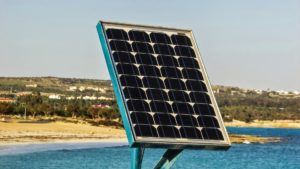
 A growing number of Photovoltaic (PV) owners are turning to energy storage as a way of managing the electrical power for their homes and businesses. The battery storage, in particular, is emerging as a popular item in the renewable energy mix. Pairing this with PVs or other renewable sources helps customers to own complete energy systems and become partly or fully self-reliant.
A growing number of Photovoltaic (PV) owners are turning to energy storage as a way of managing the electrical power for their homes and businesses. The battery storage, in particular, is emerging as a popular item in the renewable energy mix. Pairing this with PVs or other renewable sources helps customers to own complete energy systems and become partly or fully self-reliant.
A typical combination of solar and battery power enables a customer to reduce their grid consumption by about 80 percent. However, this may vary according to location, individual consumption, time of use, as well as the size of the Photovoltaic system and battery storage.
Challenges and trends in battery storage
Despite the benefits of energy storage, the high cost of the batteries has been one of the major setbacks that have prevented many PV owners from installing these systems. However, today’s battery systems are more affordable, easy to install and maintain. This is causing an increase in the number of owners adding or upgrading storage to their existing systems.
The growth is attributed to better technology and dropping prices. Companies such as Panasonic, Tesla and LG Chem are now producing better performing and low-cost Lithium-ion batteries. Additionally, there are now plug and play battery systems such as Tesla Powerwall, Enphase Ac Battery, SonnenBatterie Eco, and more.
Further, there are emerging business models, such as the energy storage-as-a-service (ESaaS), where customers do not have to pay upfront but only pay for using the storage system. In a typical ESaaS, the company installs the system for the customer and continues providing a range of related services that allow the customer to save energy costs, generate revenue, and improve the electricity resiliency.
How battery energy storage systems work
 When the solar or other renewable source generates electricity, it powers the appliances directly, but at the same time it will charge the batteries. Once the batteries are full, the PV owner can export any excess power to the grid and earn electricity credits.
When the solar or other renewable source generates electricity, it powers the appliances directly, but at the same time it will charge the batteries. Once the batteries are full, the PV owner can export any excess power to the grid and earn electricity credits.
The energy a customer stores in the battery during peak generation times is useful during the night or other times when energy from the renewable source is low. This enables PV owners to reduce the amount of power they buy from the utility, hence increasing their own energy independence.
Some storage systems do not provide a backup functionality. A special switching mechanism is necessary to make secure and safe connections that do not risk the lives of those working on downed lines. This will also protect the renewable system and other equipment on the customer’s premises.
Adding backup functionality using AC coupling
 One of the limitations of some grid-tied photovoltaic systems is that the owner will only benefit as long as there is sunlight while the grid is functioning. Otherwise, if there is an outage, they may not even use the energy they are generating from the rooftop. During such times when the grid is disconnected, the owner can neither use the rooftop solar nor export the energy to the grid.
One of the limitations of some grid-tied photovoltaic systems is that the owner will only benefit as long as there is sunlight while the grid is functioning. Otherwise, if there is an outage, they may not even use the energy they are generating from the rooftop. During such times when the grid is disconnected, the owner can neither use the rooftop solar nor export the energy to the grid.
Owners of PV systems without backup functionalities can upgrade by adding AC coupling. This enables them to store energy and use it anytime, including during emergencies and grid outages. The AC coupling converts a simple grid-tied system into a Grid/hybrid or grid interactive system. This provides grid-ties savings whenever the grid is up and running, and off-grid independence, as well as security when there is a utility outage.
The main components of AC coupling include an energy storage system, a grid-interactive inverter/charger, a coupling device and the second panel with additional wiring for the critical loads to supply during outages.
Benefits of energy storage system
Battery storage enables better power management by providing a number of benefits which include:
- Maximizing self-consumption, by storing the excess energy, which would otherwise go to waste unless connected to the grid under a suitable tariff.
- Reducing the grid network or utility costs. The owner uses battery storage during the peak periods hence avoids high electricity costs. Utility customers without solar can also charge batteries during off-peak times and use the stored energy when electricity costs are higher during peak periods.
- Providing the home with backup power when the grid is down.
- Reducing demand charges.
- Improving the electricity resiliency.

